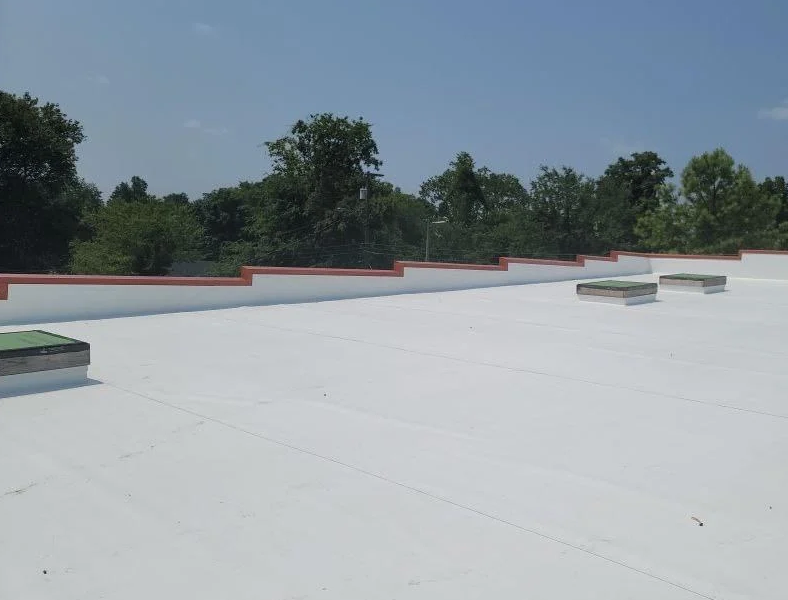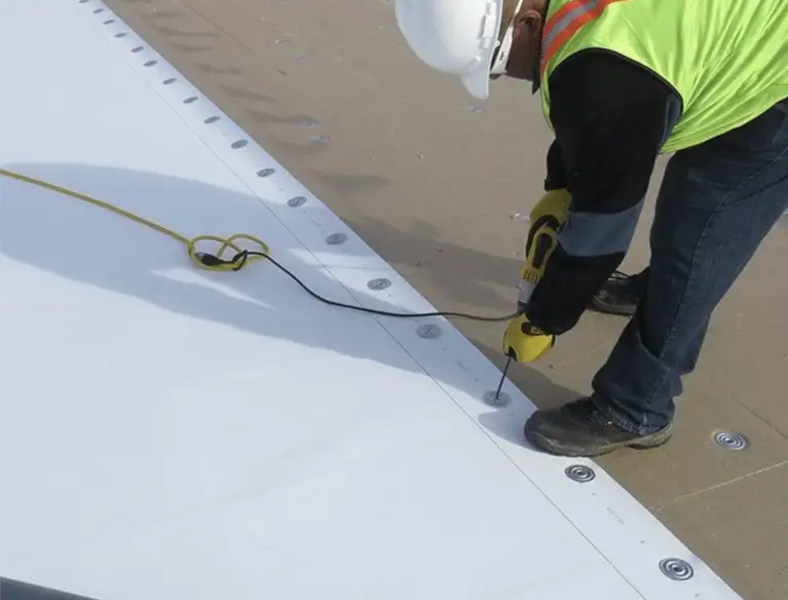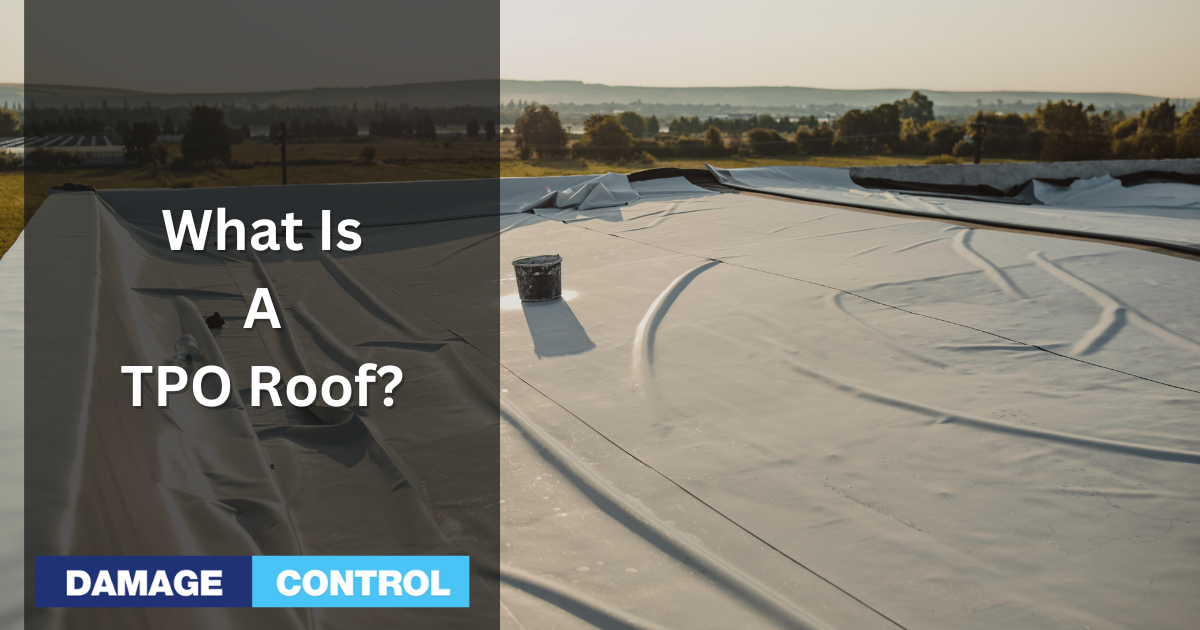Welcome to the ultimate beginner's guide to TPO roofing! If you're in the market for a new roof, TPO (thermoplastic olefin) is a roofing material worth considering. In this guide, we'll cover everything you need to know about TPO roofing, from its background to its benefits and comparisons with other roofing materials. So, let's dive in!
What is TPO Roofing?

Definition
TPO roofing, or Thermoplastic Olefin, has it all. It's cost-effective. It's eco-friendly. And it's a single-ply roofing membrane with durability and resistance to UV rays. This popular choice is common for commercial and industrial buildings. But guess what? It's catching on in the residential market too.
Thermoplastic Olefin (TPO) composition
So, what's in a TPO membrane? It's a blend of polypropylene, ethylene-propylene rubber, and other ingredients. The result? A flexible, durable, and weather-resistant surface. It's a champ at handling extreme temperatures. Perfect for hot summers and cold winters. Plus, its white reflective surface keeps buildings cool. That means lower energy costs and a greener option for the planet.
History and evolution of TPO roofing
Let's take a trip back to the early 1990s. TPO roofing was the new kid on the block. It offered an alternative to PVC and EPDM roofing systems. The goal? Combine the best of both worlds. The durability and flexibility of EPDM. The energy efficiency and resistance to chemicals from PVC. And just like that, TPO became a game-changer in the roofing industry.
Types of TPO Roofing Membranes
Thickness options
One size doesn't fit all. That's true for TPO roofing membranes too. They come in different thicknesses, ranging from 45 mils to 80 mils. Thicker membranes offer better durability and puncture resistance. But remember, the thicker the membrane, the higher the cost. It's all about finding the right balance for your specific needs.
Color options
TPO roofing doesn't have to be boring. It's available in various colors. Sure, the classic white is still a favorite. It reflects sunlight, reduces heat absorption, and keeps energy costs down. But you can also find TPO membranes in gray, tan, or other custom colors. Express your style while keeping your building cool and energy-efficient.
Specialty TPO roofing membranes
Looking for something extra? Specialty TPO roofing membranes have you covered. There are options with advanced UV resistance, better fire ratings, or enhanced energy efficiency. Some even come with self-adhering technology, making installation a breeze. Explore the world of specialty TPO membranes and find the perfect fit for your unique project.
Key Components of a TPO Roofing System
TPO membrane
At the heart of any TPO roofing system lies the TPO membrane. This single-ply, versatile layer offers durability, flexibility, and weather resistance. It's the star of the show, providing protection against the elements and contributing to energy efficiency.
Insulation
Stay warm. Stay cool. Insulation is the key. A TPO roofing system includes insulation beneath the membrane. Common materials are polyisocyanurate (ISO), expanded polystyrene (EPS), or extruded polystyrene (XPS). Each option has its pros and cons. But they all work to regulate your building's temperature and improve energy efficiency.
Attachment methods
Hold it down. A TPO roofing system needs proper attachment methods. Three popular options are:
- Mechanically attached – uses plates and fasteners to secure the membrane.
- Fully adhered – bonds the membrane to the insulation with adhesive.
- Ballasted – weights down the membrane with gravel or pavers.
Each method has its perks. Talk to a pro to find the best fit for your project.
Flashing and accessories
Details matter. Flashing and accessories complete a TPO roofing system. They seal the deal, preventing water infiltration and potential damage. Flashing covers vulnerable areas like vents, pipes, and edges. Accessories include walkway pads, termination bars, and seam plates. Get the right components, and your TPO roof will stand the test of time.
Benefits of TPO Roofing
Energy efficiency
Save energy, save money. TPO roofing is a winner when it comes to energy efficiency. Its reflective surface bounces sunlight away from the building. That means less heat absorption and a cooler interior. Lower cooling costs? Yes, please.
Durability
Built to last. TPO roofing is tough stuff. It resists punctures, tears, and impact damage. It can also handle temperature fluctuations without cracking. This roofing system is in it for the long haul.
Weather resistance
Rain or shine, TPO's got you covered. It's designed to resist UV rays, algae growth, and even chemical exposure. Plus, it can withstand strong winds and heavy rain. TPO roofing is your building's first line of defense against the elements.
Cost-effectiveness
Great value, great performance. TPO roofing offers the best of both worlds. It's more affordable than PVC roofing but still provides excellent durability and energy efficiency. It's a budget-friendly choice that doesn't skimp on quality.
Ease of installation
No fuss, no muss. TPO roofing is a breeze to install. Its lightweight and flexible nature make it easy to handle. Plus, its wide sheets mean fewer seams, cutting down on labor time. Get your TPO roof up and running in no time flat.
Limitations of TPO Roofing
Potential seam failure
Nothing's perfect. TPO roofing has its flaws too. One concern is potential seam failure. Over time, seams can weaken, allowing water to infiltrate the building. Proper installation and maintenance are crucial to avoid this issue.
Inconsistency in material quality
Buyer beware. Not all TPO roofing is created equal. Some manufacturers use lower-quality materials, leading to subpar performance. Do your homework. Choose a reputable brand that meets industry standards.
Limited history of long-term performance
The new kid on the block. TPO roofing hasn't been around as long as other options like EPDM or PVC. That means its long-term performance is still a bit of a mystery. So far, it's shown promising results. But keep an eye on your TPO roof to ensure it stands the test of time.
Comparing TPO Roofing to Other Roofing Options
TPO vs. EPDM
TPO or EPDM? Both are single-ply roofing options. TPO's got the edge when it comes to energy efficiency, thanks to its reflective surface. EPDM is a black rubber material, so it absorbs heat. But EPDM has a longer track record and can last over 30 years with proper maintenance. Both are durable, but TPO offers better resistance to chemicals and UV rays.
TPO vs. PVC
PVC, meet your match. TPO and PVC share many similarities. Both offer excellent durability, energy efficiency, and chemical resistance. But TPO has a lower price tag, making it the more budget-friendly option. PVC has a longer history in the market, but TPO is quickly becoming a worthy competitor.
TPO vs. Modified Bitumen
Apples and oranges. TPO and modified bitumen are different animals. Modified bitumen is a multi-ply asphalt-based roofing system. It's durable and weather-resistant, but it lacks TPO's energy efficiency. TPO's reflective surface keeps buildings cooler, reducing energy costs. Modified bitumen is heavier and requires more labor-intensive installation.
TPO vs. Metal Roofing
The clash of the titans. TPO and metal roofing both offer durability and weather resistance. Metal roofing can last 40+ years, while TPO's lifespan is around 20-30 years. But TPO wins in energy efficiency, reflecting sunlight and keeping buildings cooler. Metal roofing can absorb heat, increasing cooling costs. TPO is also more budget-friendly than metal roofing.
TPO Roofing Installation Process

Preparing the roof deck
First things first. Start with a clean, dry roof deck. Remove any debris and make sure it's free of moisture. Repair any damaged areas to ensure a stable foundation for your TPO roofing system.
Installing insulation
Layer it up. Install insulation boards on the roof deck. Remember, insulation helps regulate the building's temperature and improves energy efficiency. Secure the boards with adhesive, fasteners, or both. Keep it snug and smooth, avoiding gaps and overlaps.
Laying the TPO membrane
Roll it out. Unroll the TPO membrane over the insulation. Align the sheets, leaving enough overlap for welding seams. Let the membrane relax for a bit. This step helps minimize wrinkles and ensures proper adhesion.
Welding seams
Seal the deal. Use a hot-air gun to weld the seams between TPO sheets. Properly welded seams create a watertight barrier, preventing leaks and potential damage. Double-check the welds to make sure they're strong and secure.
Installing flashing and accessories
Don't forget the details. Install flashing around vulnerable areas like vents, pipes, and edges. Accessories like walkway pads, termination bars, and seam plates complete the system. These components help protect your TPO roof from water infiltration and damage.
Inspecting the completed installation
Last but not least. Give your TPO roofing system a thorough inspection. Make sure everything is properly installed, welded, and sealed. A well-installed TPO roof ensures long-lasting performance and protection for your building.
TPO Roofing Maintenance and Repair
Regular maintenance tasks
Keep it clean. Regular maintenance is crucial for a long-lasting TPO roof. Clear debris like leaves, dirt, and branches. Check for signs of wear and tear, especially around seams and flashing. Schedule routine inspections, ideally twice a year or after severe weather events.
Identifying and addressing common issues
Stay vigilant. Common TPO roofing issues include seam failures, punctures, and membrane shrinkage. Check for water infiltration, ponding water, or damaged flashing. Catching problems early can save you time and money in the long run.
Repair methods and materials
Patch it up. TPO roofing repairs are usually straightforward. Use TPO-specific materials like seam primer, cover tape, or repair membranes. Welding or using a TPO-compatible adhesive ensures a proper bond. For larger issues, consult a professional to assess the damage and recommend the best course of action. Keep your TPO roof in top shape with regular maintenance and timely repairs.
TPO Roofing Costs
Factors influencing costs
What's the price tag? TPO roofing costs depend on various factors. Material thickness, insulation choice, and attachment method all play a role. Labor rates, regional costs, and building size also impact the bottom line.
Cost comparison with other roofing options
How does TPO stack up? It's more affordable than PVC and metal roofing but slightly more expensive than EPDM. TPO offers a great balance of cost-effectiveness, durability, and energy efficiency, making it a popular choice in the roofing market.
Calculating return on investment
Do the math. TPO roofing's energy efficiency can lead to significant savings on cooling costs. Combine that with its durability and low maintenance requirements, and you've got a solid return on investment. Don't forget to factor in any rebates or incentives for energy-efficient roofing systems.
National Average Cost
Show me the numbers. The national average cost for TPO roofing installation ranges from $5 to $9 per square foot. This includes materials, labor, and disposal of old roofing. Keep in mind that costs can vary based on your specific project and location. Get multiple quotes from reputable contractors to ensure you're getting the best deal for your TPO roofing system.
Frequently Asked Questions
How long does TPO roofing last?
TPO roofing typically lasts between 20 and 30 years, depending on maintenance, weather conditions, and installation quality. Proper care and regular inspections can extend its lifespan.
Can TPO roofing be installed over an existing roof?
Sometimes. It depends on local building codes, the condition of the existing roof, and the type of existing roofing material. Consult a professional contractor to determine if installing TPO over an existing roof is an option for your project.
What is the best TPO roofing color for energy efficiency?
White TPO roofing is the most energy-efficient color option. Its reflective surface bounces sunlight away, reducing heat absorption and keeping the building cooler. This leads to lower energy costs and a more comfortable interior.
Can TPO roofing be painted?
Technically, yes. But painting TPO roofing can reduce its energy efficiency and may void the manufacturer's warranty. Consult your roofing contractor and the manufacturer before considering painting your TPO roof.
How do I know if my TPO roof needs repair or replacement?
Look for signs of wear and tear, such as seam failures, punctures, or membrane shrinkage. Water infiltration and damaged flashing are also indicators. Schedule an inspection with a professional contractor to assess the damage and recommend the best course of action.
Can TPO roofing be installed on a sloped roof?
Absolutely. TPO roofing is suitable for both low-slope and steep-slope roofs. Its lightweight and flexible nature allows for easy installation on various roof shapes and slopes.
Conclusion
TPO roofing is a star player in the roofing world. It offers energy efficiency, durability, and weather resistance at a budget-friendly price. But don't forget, proper installation and maintenance are crucial for long-lasting performance.
Do your homework. Research reputable brands and contractors. Consult with professionals to find the best TPO roofing system for your project. And remember, a well-maintained TPO roof is an investment that pays off in the long run.
Now that you're well-versed in TPO roofing, it's time to explore other roofing options and details. Dive deeper into the world of roofing by checking out these informative articles:
- Looking for even more resources? Visit our roofing information and guides section for comprehensive knowledge on all things roofing.
Equip yourself with the knowledge to make the best choices for your roofing needs.

